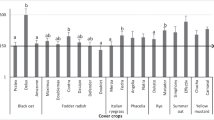Abstract
Experiments simulating interplanting of resistant rootstocks with susceptible rootstocks that maintain high population densities of Tylenchulus semipenetrans in field soil were carried out in microplots at two locations, and in an naturally infested orchard. Selections of Cleopatra mandarin (03) × Poncirus trifoliata (01) 03.01.5 and 03.01.13, Citrus volkameriana (23) × P. trifoliata 23.01.17, Troyer citrange (02) × Cleopatra mandarin 02.03.24, Troyer citrange × Common mandarin (04) 02.04.18, King mandarin (05) × P. trifoliata 05.01.7, and Carrizo citrange were exposed to continuous high population densities of a population of the Mediterranean biotype of T. semipenetrans. The selection 23.01.17 retained its resistance in the microplots and in the field (< 1.2% females and eggs per gram fibrous root of those on Carrizo citrange). The selection 03.01.5 also retained its resistance in the microplots at Moncada (< 0.5% females and eggs per gram fibrous root of those on Carrizo citrange) but numbers of females and eggs per gram fibrous root were 27% and 22% at Amposta, and 139% and 18% in the orchard of those on Carrizo citrange, respectively. The selection 05.01.7 supported equal number of females and 43% eggs per gram fibrous root of those on Carrizo citrange in the nematode-infested orchard. The remaining selections supported high populations of T. semipenetrans.
Similar content being viewed by others
References
Baines RC, Cameron JW and Soost RK (1974) Four biotypes of Tylenchulus semipenetrans in California identified, and their importance in the development of resistant citrus rootstocks. Journal of Nematology 6: 63-66
Barker KR (1985) Design of greenhouse and microplot experiments for evaluation of plant resistance to nematodes. In: Zukerman BM, Mai WF and Harrison MB (eds) Plant Nematology Laboratory Manual (pp 107-113) University of Massachusetts Agriculture Experimental Station, Amherst USA
Cambra M (1994) El virus de la tristeza de los cítricos. Nueva situación en la Comunidad Valenciana. Phytoma España 58: 26-31
Duncan LW, Inserra RN, O'Bannon JH and El-Morshedy MM (1994) Reproduction of a Florida population of Tylenchulus semipenetrans on resistant citrus rootstocks. Plant Disease 78: 1067-1071
Esmenjaud D, La Massèse CS, Salesses G, Minot JC and Voisin R (1992) Method and criteria to evaluate resistance to Meloidogyne arenaria in Prunus cerasifera Ehr. Fundamental and Applied Nematology 15: 385-389
Esmenjaud D, Minot JC and Voisin R (1996) Effects of durable inoculum pressure and high temperature on root galling, nematode numbers and surviral of Myrobalan plum genotypes (Prunus cerasifera Ehr.) highly resistant to Meloidogyne spp. Fundamental and Applied Nematology 19: 85-90
Forner JB and Pina JA (1992) Plantones tolerantes a tristeza. Veinte años de historia (I). Patrones. Levante Agrícola 319: 88-92
Forner JB, Alcaide A, Verdejo-Lucas S and Sorribas FJ (1996) New hybrids as citrus rootstocks in Spain. Proceeding of the International Society of Citriculture (pp 167-170) Sun Lake City, South Africa
Forner JB, Forner MA, Alcaide A, Verdejo-Lucas S and Sorribas FJ (2003) New hybrid citrus rootstock released in Spain. Proceeding of the International Society of Citriculture Florida, IX Congress 2000, Vol. I, pp. 58-61
Galeano M, Verdejo-Lucas S, Sorribas FJ, Ornat C, Forner JB and Alcaide A (2003) Resistance to Tylenchulus semipenetrans Cobb in selections of Cleopatra mandarin × Poncirus trifoliata exposed to increasing inoculum densities. Nematology 5, in press
Hutchinson DJ (1985) Rootstock development, screening and selection for disease tolerance and horticultural characteristics. Fruit Varieties Journal 39: 21-25
Jenkins WR (1964) A rapid centrifugal flotation technique for separating nematodes from soil. Plant Disease Reporter 48: 69
Kaplan DT (1981) Characterization of citrus rootstock responses to Tylenchulus semipenetrans (Cobb). Journal of Nematology 13: 492-498
Kaplan DT (1988) Future considerations for nematode management in citrus. In: Goren R and Mendel K (eds) Proceedings of the Sixth International Citrus Congress (pp 969-975) Balaban Publishers, Tel Aviv Israel
Kaplan DT and O'Bannon JH (1981) Evaluation and nature of citrus nematode resistance in 'Swingle' citrumelo. Proceedings of Florida State Horticultural Society 94: 33-36
Ling P, Duncan LW, Deng Z, Dunn D, Hu X, Huang S and Gmitter FG Jr (2000) Inheritance of citrus nematode resistance and its linkage with molecular markers. Theoretical and Applied Genetics 100: 1010-1017
Mashela P, Duncan L and McSorley R (1992) Salinity reduces resistance to Tylenchulus semipenetrans in citrus rootstocks. Nematropica 22: 7-12
McSorley R, Parrado JL and Dankers WH (1984) A quantitative comparison of some methods for the extraction of nematodes from roots. Nematropica 14: 72-84
Starr JL, Bridge J and Cook R (2002) Resistance to plant-parasitic nematode: History, current use and future potential. In: Starr JL, Bridge J and Cook (eds) Plant Resistance to Parasitic Nematodes (pp 1-22) CABI Publishing, Wallingford UK
Van Gundy SD and Kirkpatrick JD (1964) Nature of resistance in certain citrus rootstocks to citrus nematode. Phytopathology 54: 419-427
Verdejo-Lucas S and Kaplan DT (2002) The citrus nematode: Thylenchulus semipenetrans. In: Starr JL, Bridge J and Cook (eds) Plant Resistance to Parasitic Nematodes (pp 207-219) CABI Publishing, Wallingford UK
Verdejo-Lucas S, Sorribas FJ, Forner JB and Alcaide A (1997a) Screening hybrid citrus rootstocks for resistance to Tylenchulus semipenetrans Cobb. HortScience 32: 1116-1119
Verdejo-Lucas S, Sorribas FJ, Pons J, Forner JB and Alcaide A (1997b) Biotypes of Tylenchulus semipenetrans from Spanish citrus orchards. Fundamental and Applied Nematology 20: 399-404
Verdejo-Lucas S, Sorribas FJ, Forner JB and Alcaide A (2000a) Resistance of hybrid citrus rootstocks to a Mediterranean biotype of Tylenchulus semipenetrans Cobb. HortScience 35: 269-273
Verdejo-Lucas S, Sorribas FJ, Forner JB, Alcaide A, Ornat C and Galeano M (2000b) Evaluating resistance to Tylenchulus semipenetrans Cobb in hybrid citrus rootstocks in Spain. Proceeding of the International Society of Citriculture Florida, IX Congress 2000, Vol. I, pp. 818-822
Author information
Authors and Affiliations
Rights and permissions
About this article
Cite this article
Verdejo-Lucas, S., Galeano, M., Sorribas, F. et al. Effect on Resistance to Tylenchulus semipenetrans of Hybrid Citrus Rootstocks Subjected to Continuous Exposure to High Population Densities of the Nematode. European Journal of Plant Pathology 109, 427–433 (2003). https://doi.org/10.1023/A:1024220417737
Issue Date:
DOI: https://doi.org/10.1023/A:1024220417737




